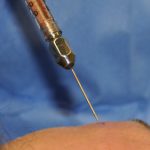1. What are the different types of fat grafting?
Fat grafting in plastic surgery in various forms has been around for over fifty years. More solid forms of fat grafts, known as dermal fat grafts, has a long history of successful use when the size of the graft is relatively small. But having to use a cut out of skin to obtain this type of fat graft, leaving a scar, relegates dermal fat grafts to more limited uses.
Liposuction is responsible for the concept of injectable fat grafting. Seeing so much liquefied fat discarded made the consideration of ‘recycling’ a logical one. Concentration of the liposuctioned fat through straining or centrifugation makes for a fat concentrate that is easily injectable. Many different methods are used to prepare this fat concentrate and there is no single method that is conclusively proven to be better than another. The discovery of high concentrations of stems in fat has led to more widespread use of this injectable approach.
2. How is injectable fat grafting done?

One of the unproven and potential innovations in injectable fat grafting is to mix certain agents in with the fat to help it survive better after transplantation. Currently, the most popular agent is an extract of the patients own blood known as platelet-rich plasma or PRP. The theory is that the growth factors in the platelets may help stimulate the stem cells to become new fat cells in the injected site.
3. What is fat grafting used for?
Injectable fat grafting is used for volume fill of numerous facial areas and one specific body area, the buttocks. The locations on the face include a variety of sites from the forehead, temples, upper eyelid, cheeks, lips, chin, and sides of the face. Injecting into the buttocks is well established. Breast augmentation with fat injections is both controversial and unproven.
4. How well does fat grafting work? Will someone else’s fat work in me?
The logic and simplicity of fat injections for numerous cosmetic applications leaves plastic surgeons optimistic about its future. Its single downside, and a significant one, is that its take is highly variable. No one can predict with any certainty how much will survive in any specific body area. It is a highly influenced by both surgical technique and unknown factors in each patient’s fat.
Certain areas of injection do seem to be more favorable such as the cheeks in the face and the buttocks in the body. One of the least successful areas, unfortunately, is that of the lips. It is known that a series of fat injections (more than one session)can increase the amount of fat which is retained.
Just like all other types of tissues, fat grafts are person specific. They will only work if it comes from you.
5. How is fat grafting used for ‘volumetric facial rejuvenation’?
As we age, one of the effects on the face is that of volume loss or fat atrophy. While it does not affect everyone, many faces become more gaunt which also causes skin to sag. While some variations of lifting may be needed for excessively loose skin, the concept of adding volume back through fat grafting to select facial areas has become popular.
The added volume restores fullness to facial areas such as the cheeks, nasolabial folds and lips which helps to restore a more youthful look. When one is younger, fat injections may be used alone with other facial treatments (Botox, skin resurfacing) to create a non-surgical facelift or rejuvenation. In older patients, it may be combined with more conventional skin lifting procedures
Injectable facial rejuvenation can also be used when fat is lost due to medications and weight loss.
6. Which is better for buttock enlargement, fat grafts or implants?
Both implants and fat injections are proven methods for buttock augmentation. There are numerous plastic surgery advocates on both sides of this discussion. It is not a question of whether one is better but in knowing their advantages and disadvantages.
Buttock or gluteal implants offer the advantage of a predictable result that will not ever change after surgery. There are size options that always make it possible to get an adequate result. Its disadvantages are that it is a bigger operation with a longer recovery and exposes one to all the risks of an implanted material. These include fluid collections, known as seromas, infection, implant displacement and asymmetry, and chronic pain.
Injectable fat grafting has the advantages of not being an implant, thus avoiding any implant risks, and harvesting from the donor site provides a secondary cosmetic benefit. It also has a fairly quick and comfortable recovery. Its disadvantages are that its survival is unpredictable and its best results come when multiple injection sessions are done. (which also adds to the expense)
7. Can fat grafting be used instead of breast implants?
The interest in using a natural material for breast augmentation instead of an implant is understandably high. It certainly sounds appealing to put into a breast what is primarily composed of…fat. Although there are a few select locations around the world where this technique of breast augmentation is done, it is far from a perfected method and its long-term results are largely unproven.
One of the issues is that the survival of the fat grafts is variable so only a modest amount of fat can be injected into each breast during a single procedure. (generally only several hundred ccs) That is at the very low range of augmentation and is only comparable to the smallest of breast implants. Another concern is that some of the fat may undergo necrosis and result in areas of scar. Besides making the breast ‘lumpy’, these areas can also make the breast more difficult to evaluate for cancer.
While injectable fat grafting may one day be a good method for breast augmentation, implants continue to be create more predictable and reliable results.
Dr. Barry Eppley
Indianapolis, Indiana


